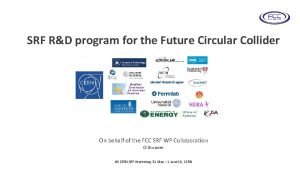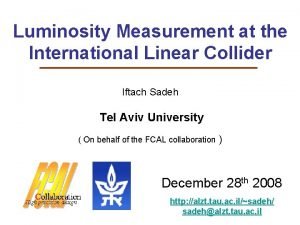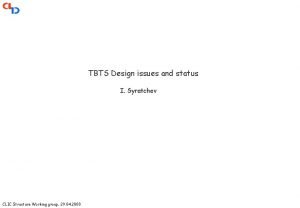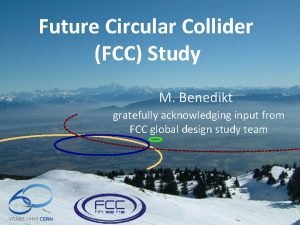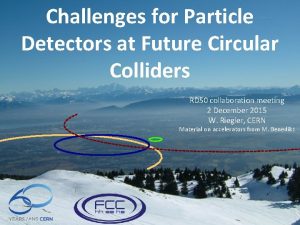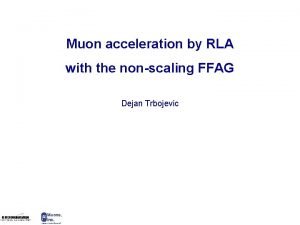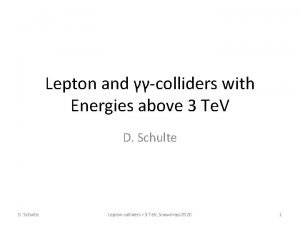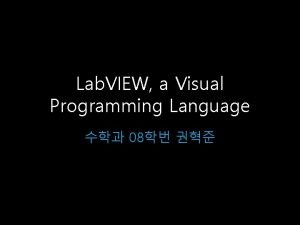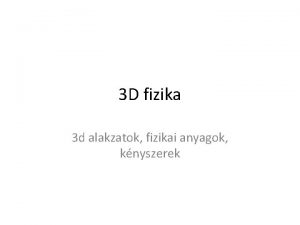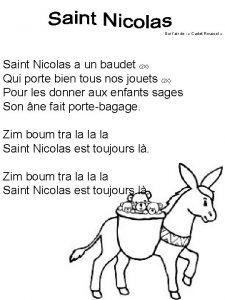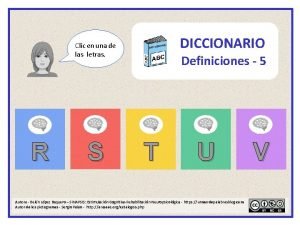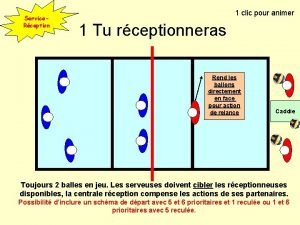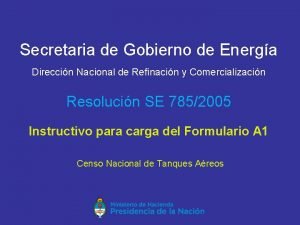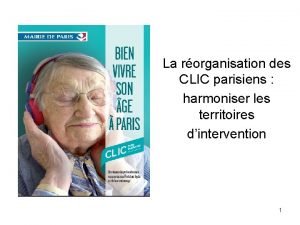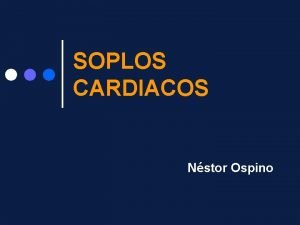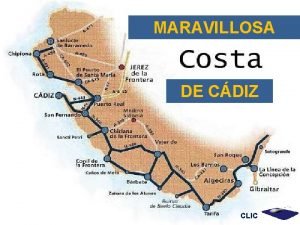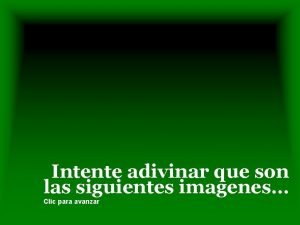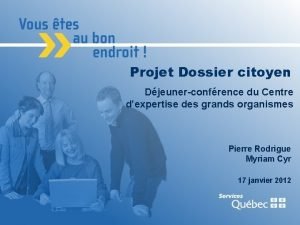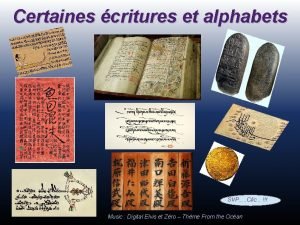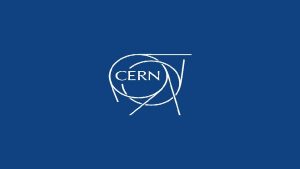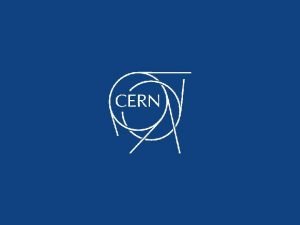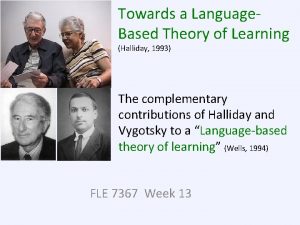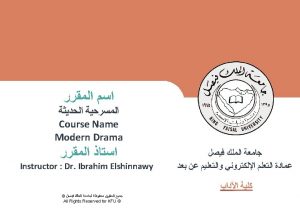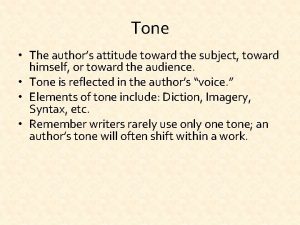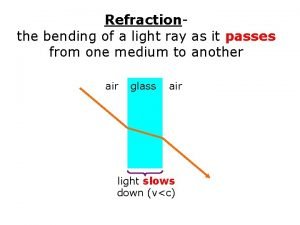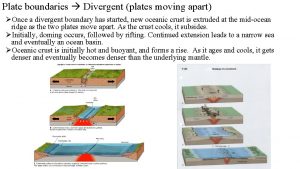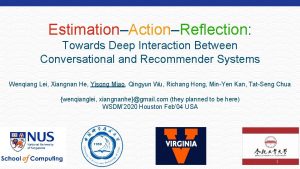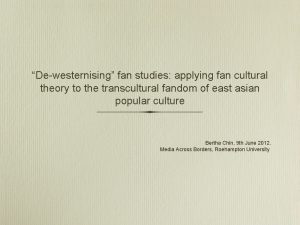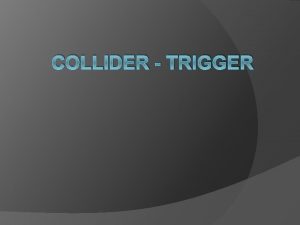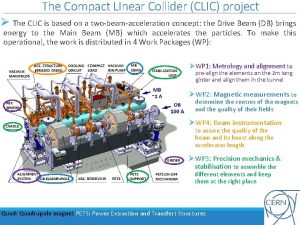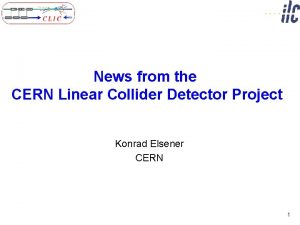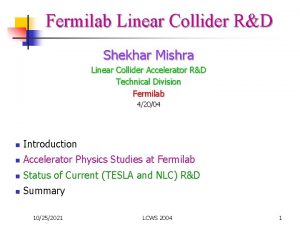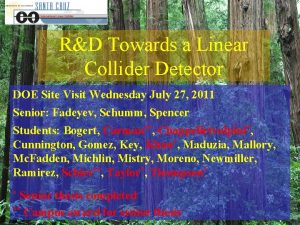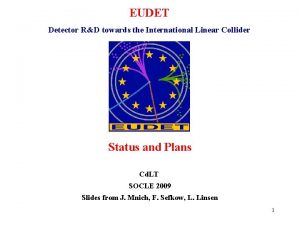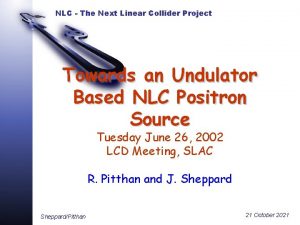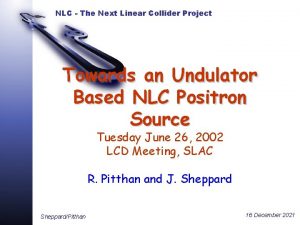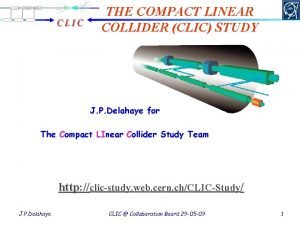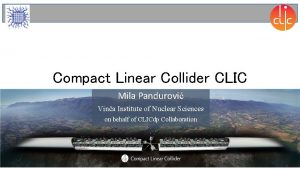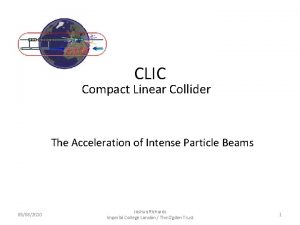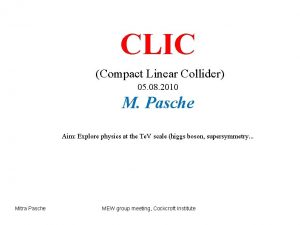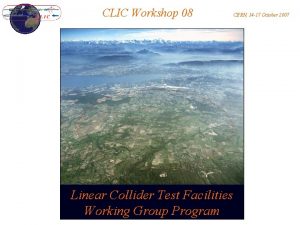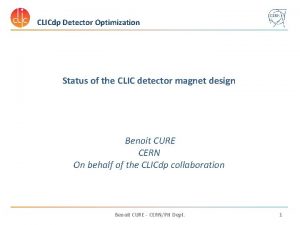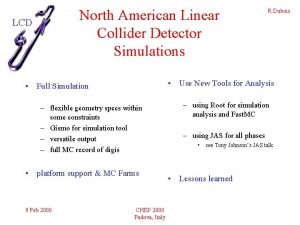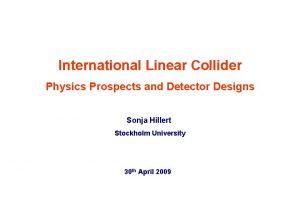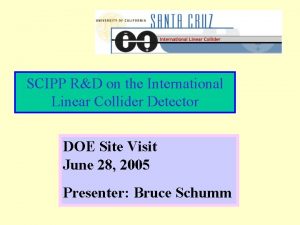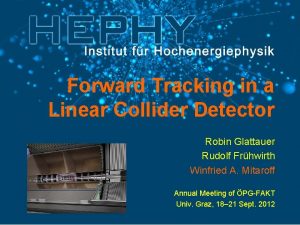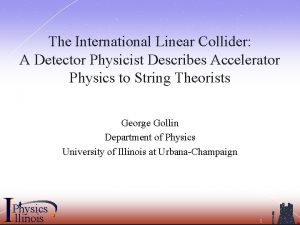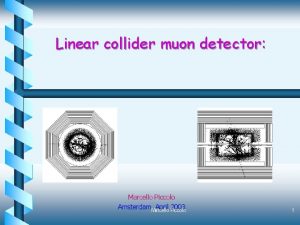Linear Collider Detector project CERN towards a CLIC











































- Slides: 43

Linear Collider Detector project @ CERN towards a CLIC (ILC) detector R&D Lucie Linssen CERN Lucie Linssen, ESE presentation, 17/3/2008 1

Outline and useful links Outline: • Short introduction to the CLIC accelerator • Linear Collider Detector project @ CERN • CLIC detector issues – difference wit ILC case • CLIC detector R&D • Outlook Useful links: • Linear Collider Detector project at CERN • http: //lcd. web. cern. ch/LCD/New. Welcome. html • CLIC 08 workshop, October 14 -17 2008 • http: //project-clic 08 -workshop. web. cern. ch/project-clic 08 -workshop/ Lucie Linssen, ESE presentation, 17/3/2008 2

The CLIC Two Beam Scheme: Drive Beam supplies RF power • 12 GHz bunch structure • low energy (2. 4 Ge. V - 240 Me. V) • high current (100 A) Main beam for physics • high energy (9 Ge. V – 1. 5 Te. V) • current 1. 2 A No individual RF power sources Lucie Linssen, ESE presentation, 17/3/2008 3

326 klystrons 33 MW, 139 ms combiner rings drive beam accelerator Circumferences delay loop 80. 3 m CR 1 160. 6 m CR 2 481. 8 m 2. 37 Ge. V, 1. 0 GHz 1 km delay loop CR 2 drive beam accelerator 2. 37 Ge. V, 1. 0 GHz delay loop CR 1 1 km Drive Beam Generation Complex decelerator, 24 sectors of 868 m BC 2 245 m main linac , 12 GHz, 100 MV/m, TA e- R=120 m 21. 04 km BDS 2. 75 km BC 2 245 m IP 1 e+ main linac R=120 m 48. 3 km CLIC overall layout 3 Te. V booster linac, 9 Ge. V, 2 GHz BC 1 e- injector 2. 4 Ge. V TA e- DR 365 m e+ injector, e+ DR 2. 4 Ge. V 365 m Lucie Linssen, ESE presentation, 17/3/2008 Main Beam Generation Complex Main & Drive Beam generation complexes not to scale 4

Dr iv e Be am M CLIC ai n Be am two-beam module Lucie Linssen, ESE presentation, 17/3/2008 5

Main beam accelerating structures Objective: • Withstand of 100 MV/m without damage • Breakdown rate < 10 -7 • Strong damping of HOMs Technologies: Brazed disks - milled quadrants Collaboration: CERN, KEK, SLAC Lucie Linssen, ESE presentation, 17/3/2008 6

Best result so far High Power test of T 18_VG 2. 4_disk (without damping) • Designed at CERN, • Machined by KEK, • Brazed and tested at SLAC Improvement by RF conditionning CLIC target Design: 100 MV/M loaded BR: 10 -7 Lucie Linssen, ESE presentation, 17/3/2008 7

CLIC test facility CTF 3 Demonstrate Drive Beam generation TL 1 (fully loaded acceleration, beam intensity and bunch frequency multiplication x 8) 2005 Demonstrate RF Power Production and test Power Structures 2004 DL Demonstrate Two Beam Acceleration and test Accelerating Structures CR Operational Experience (reliability) by continuous operation (10 m/year) Beam up to dump (August 08) CLEX TL 2 INJECTOR First module Cleaning Chicane Jan 2007 Lucie Linssen, ESE presentation, 17/3/2008 8

World-wide CLIC / CTF 3 accelerator collab. http: //clic-meeting. web. cern. ch/clic-meeting/CTF 3_Coordination_Mtg/Table_Mo. U. htm 24 members representing 27 institutes involving 17 funding agencies of 15 countries 27 collaborating institutes Ankara University (Turkey) BINP (Russia) CERN CIEMAT (Spain) Cockcroft Institute (UK) Gazi Universities (Turkey) IRFU/Saclay (France) Helsinki Institute of Physics (Finland) IAP (Russia) IAP NASU (Ukraine) Instituto de Fisica Corpuscular (Spain) JINR (Russia) JLAB (USA) KEK (Japan) LAL/Orsay (France) LAPP/ESIA (France) INFN / LNF (Italy) EPAC 2008 CLIC / CTF 3 G. Geschonke, CERN NCP (Pakistan) Lucie J. Adams Linssen, Institute, (UK)ESE presentation, 17/3/2008 North-West. Univ. Illinois (USA) University of Oslo (Norway) PSI (Switzerland), Polytech. University of Catalonia (Spain) RRCAT-Indore (India) Royal Holloway, Univ. London, (UK) SLAC (USA) Uppsala University (Sweden) 9 9

CLIC parameters Center-of-mass energy Total (Peak 1%) luminosity CLIC 500 Ge. V CLIC 3 Te. V 2. 3 (1. 4)· 1034 5. 9 (2. 0)· 1034 Repetition rate (Hz) Loaded accel. gradient MV/m 50 80 Main linac RF frequency GHz Bunch charge [109] 100 12 6. 8 Bunch separation (ns) 3. 72 0. 5 Beam pulse duration (ns) 177 156 Beam power/beam (MWatts) 4. 9 14 Hor. /vert. IP beam size (nm) 202 / 2. 3 40 / 1. 0 Hadronic events/crossing at IP 0. 19 2. 7 Coherent pairs at IP 100 3. 8 108 BDS length (km) 1. 87 2. 75 Total site length km 13. 0 48. 3 Total power consumption MW 129. 4 415 Lucie Linssen, ESE presentation, 17/3/2008 10

Collaboration between ILC and CLIC Since February 2008: official collaboration between ILC and CLIC http: //clic-study. web. cern. ch/CLIC-Study/CLIC_ILC_Collab_Mtg/Index. htm CLIC ILC Physics & Detectors L. Linssen, D. Schlatter F. Richard, S. Yamada Beam Delivery System (BDS) & Machine Detector Interface (MDI) D. Schulte, R. Tomas Garcia E. Tsesmelis B. Parker, A. Seriy Civil Engineering & Conventional Facilities C. Hauviller, J. Osborne, V. Kuchler Positron Generation (new) L. Rinolfi J. Clarke Damping Rings (new) Y. Papaphilipou M. Palmer Beam Dynamics D. Schulte A. Latina, K. Kubo, N. Walker Cost & Schedule H. Braun (P. Lebrun), K. Foraz, G. Riddone J. Carwardine, P. Garbincius, T. Shidara Lucie Linssen, ESE presentation, 17/3/2008 11

LCD@CERN Linear Collider Detector project at CERN What is our goal ? We are working towards a linear collider detector which will operate in an energy range (CM) from 500 Ge. V to 3 Te. V Working together with the ILC concepts (Si. D, ILD, 4 th) and with the detector collaborations (LC-TPC, EUDET, FCAL, CALICE). In a concerted effort with the individual concepts, we work towards describing the possible changes or upgrades to the ILC concepts to make them compatible with multi-Te. V energies and CLIC beam conditions. Current schedule: CLIC CDR end 2010, CLIC TDR 2015 Lucie Linssen, ESE presentation, 17/3/2008 12

LCD@CERN, who are we? Who are we ? • LL (project leader) • Dieter Schlatter • Konrad Elsener • Peter Speckmayer (Fellow) • Christian Grefe (Doct) • Andre Sailer (Doct) • Marco Battaglia (PDSA) + part time help from CERN staff + CERN contribution to EUDET LAPP Annecy Jean-Jacques Blaising Jan Blaha (Doct) ETH Zurich Alain Hervé STFC-RAL Marcel Stanitzki Jan Strube + further contacts with ILC collaborations Lucie Linssen, ESE presentation, 17/3/2008 13

General Context • New physics expected in Te. V energy range – Higgs, Supersymmetry, extra dimensions, …? • LHC will indicate what physics, and at which energy scale ( is 500 Ge. V enough or need for multi Te. V? ) • Even if multi-Te. V is final goal, most likely CLIC would run over a range of energies (e. g. 0. 5 – 3. 0 Te. V) • ILC detector concepts are excellent starting point for high energy detector http: //documents. cern. ch/cgi-bin/setlink? base=cernrep&categ=Yellow_Report&id=2004 -005 • Like for ILC, assume 2 CLIC detectors in pull push mode Lucie Linssen, ESE presentation, 17/3/2008 14

CLIC detector issues, and comparison with ILC Lucie Linssen, ESE presentation, 17/3/2008 15

ILC experiment concepts Si. D ILD 4 th Lucie Linssen, ESE presentation, 17/3/2008 16

Harry Weerts Lucie Linssen, ESE presentation, 17/3/2008 17

CLIC detector issues 3 main differences with ILC: • Energy 500 Ge. V => 3 Te. V • More severe background conditions • Due to higher energy • Due to smaller beam sizes • Time structure of the accelerator Lucie Linssen, ESE presentation, 17/3/2008 18

CLIC time structure Train repetition rate 50 Hz CLIC: 1 train = 312 bunches 0. 5 ns apart 50 Hz ILC: 1 train = 2820 bunches 337 ns apart 5 Hz Consequences for CLIC detector: • Assess need for detection layers with time-stamping • Innermost tracker layer with sub-ns resolution • Additional time-stamping layers for photons and for neutrons (needed? ) • Readout/DAQ electronics will be different from ILC • Consequences for power pulsing? Lucie Linssen, ESE presentation, 17/3/2008 19

Beam-induced background Background sources: CLIC and ILC similar Due to the higher beam energy and small bunch sizes they are significantly more severe at CLIC. • CLIC 3 Te. V beamstrahlung ΔE/E = 29% (10×ILCvalue) – Coherent pairs (3. 8× 108 per bunch crossing) <= disappear in beam pipe – Incoherent pairs (3. 0× 105 per bunch crossing) <= suppressed by strong solenoid-field – γγ interactions => hadrons (2. 7 hadron events per bunch crossing) • Muon background from upstream linac – More difficult to stop due to higher CLIC energy (active muon shield) • + a few more standard background sources Lucie Linssen, ESE presentation, 17/3/2008 20

CLIC CM energy spectrum Due to beamstrahlung: • At 3 Te. V only 1/3 of the luminosity is in the top 1% Centre-of-mass energy bin • Many events with large forward or backward boost Lucie Linssen, ESE presentation, 17/3/2008 21

Beamstrahlung, continued…. . At 3 Te. V many events have a large forward or backward boost, plus many backscattered photons/neutrons 3 Te. V Lucie Linssen, ESE presentation, 17/3/2008 22

Lessons learnt from ILC case Adrian Vogel, DESY • Pair production is the dominant background • Most backgrounds can be controlled by a careful design • Use full detector simulation to avoid overlooking effects 10% beam crossing in ILD detector at 500 Ge. V • Innermost Vertex layer (r=1. 5 cm) has 0. 04 hits/mm 2/BX • Critical level of neutrons (radiation damage) at small radii of HCAL endcap Lucie Linssen, ESE presentation, 17/3/2008 23

Extrapolation ILC = > CLIC Full LDC detector simulation at 3 Te. V Adrian Vogel, DESY Simulation of e+e- pairs from beamstrahlung origin • Conclusion of the comparison: • ILC, use 100 BX (1/20 bunch train) • CLIC, use full bunch train (312 BX) • CLIC VTX: O(10) times more background • CLIC TPC: O(30) times more background LDC 3 Te. V, with forward mask Lucie Linssen, ESE presentation, 17/3/2008 24

Vertex Detector Daniel Schulte for re ar “b 312 BX l” => CLIC inner radius of vertex det. at R=~30 mm (15 mm for ILC) Lucie Linssen, ESE presentation, 17/3/2008 vertex opening angle 25 PRELIMINARY Vertex detector hits from incoherent pairs, B=5 T, two angular coverages

CLIC Tracking issues: • Due to beam-induced background and short time between bunches: – Inner radius of Vertex Detector has to move out (30 mm) – High occupancy in the inner regions • Narrow jets at high energy – 2 -track separation is an issue for the tracker/vertex detector – Track length may have to increase (fan-out of jet constituents)? Lucie Linssen, ESE presentation, 17/3/2008 3 Te. V - W+W- qqqq e+e 26

CLIC Calorimetry Need deep HCAL (≥ 8λi) Cannot increase coil radius too much => need heavy absorber Choice of suitable HCAL material Choice of technology (PFA or dual readout) 3 Te. V e+e- event on Si. D detector layout, illustrating the need for deeper calorimetry Lucie Linssen, ESE presentation, 17/3/2008 27

Which calorimetry at CLIC energies? To overcome known shortfalls from LEP/LHC experience, new concepts/technologies are chosen for ILC: • Based on Particle Flow Algorithm • Highly segmented (13 -25 mm 2) ECAL (analog) • Very highly segmented ECAL (digital) • Highly segmented (1 cm 2) HCAL (digital) • Segmented HCAL (analog) • Based on Dual (Triple) readout • Sampling calorimeter • Plastic fibres • Crystal fibres (<= materials studies) • Fully active calorimeter (EM part) • Crystal-based Lucie Linssen, ESE presentation, 17/3/2008 Method and Engineering difficult, but conventional Limited in energy-range to a few hundred Ge. V Method and Engineering difficult and non-proven Not limited in energy range 28

Mark Thomson CLIC 08 Lucie Linssen, ESE presentation, 17/3/2008 29

Alternative to PFA calorimetry R&D on dual/triple readout calorimetry Basic principle: • Measure EM shower component separately • Measure HAD shower component separately • Measure Slow Neutron component separately Dual Triple EM-part=> electrons => highly relativistic => Cerenkov light emission HAD-part=> “less” relativistic => Scintillation signal Slow neutrons => late fraction of the Scintillation signal Requires broader collaboration on materials + concept Lucie Linssen, ESE presentation, 17/3/2008 30

Hadron Calorimetry Peter Speckmayer / Christian Grefe Tungsten – Scintillator calorimeter Conventional Calorimetry, resolution for 8λ Lucie Linssen, ESE presentation, 17/3/2008 31

Hadron Calorimetry Peter Speckmayer / Christian Grefe 230 -270 Ge. V 6, 7, 8, 9 -> 40 λ Lucie Linssen, ESE presentation, 17/3/2008 32

Opportunities for Detector R&D and engineering studies Lucie Linssen, ESE presentation, 17/3/2008 33

Opportunities for detector R&D First assessment of R&D required for CLIC beyond present ILC developments • • Time stamping Power pulsing and adaptation of electronics readout to CLIC Alternative to PFA calorimetry (dual readout calorimetry) Mechanical engineering studies – Heavy calorimeter concept – Large high-field solenoid concept – Integration studies • Precise stability/alignment studies Other R&D activities to ensure continued good collaboration with ILC physics community • • • TPC electronics developments (S-ALTRO and Timepix 2) Participation in CALICE Core software development Lucie Linssen, ESE presentation, 17/3/2008 34

R&D for Time stamping 0. 5 nsec bunch spacing, 312 bunches/train, 50 Hz overlapping background for 312 BX will be an issue exact needs will come out of detector concept simulations • • • (sub)-ns time stamping in most inner tracking double-layer Time stamping needed for photons? => preshower Time stamping needed for neutron? => layer within HCAL Technical challenges for time-stamping in the inner tracking layer: • Critical analog design involving sensor+electronics+interconnect for good time resolution • High granularity (short strips? ) • Power consumption is an issue for high-precision TDC Lucie Linssen, ESE presentation, 17/3/2008 35

Power pulsing and other electronics developments ILC => 5 Hz • Systematic study of power-pulsing feasibility – – Needed for ILC and CLIC Leading to recommendations for optimised design Real case implementation (What about influence on wire-bonds? ) => “on”-time 0. 5% CLIC => 50 Hz => “on”-time 10 -5 • Overall electronics implementation compatible with CLIC time-structure – Study of the adaptations required (analog, digital, readout sequence) • Readout full bunch trains or fraction of it? • Where to buffer the data? When to reduce the data? • Implementation of some of the ILC vertex/tracker/calo hardware developments for CLIC Lucie Linssen, ESE presentation, 17/3/2008 36

TPC electronics developments • S-ALTRO pad readout – – – Ultimate aim: compact on-chip readout system for MPGD signals Measure tracks in 3 D and DE/Dx => need for high precision High data reduction capability Pad readout sizes typically 1*4 mm 2 Basic microelectronics aspects addressed in EUDET (financed up to end 2009) Need for system studies and iteration on microelectronics part • Timepix 2 development – – – Pixel readout of MPGD signals Preamp – shaper – discriminator Time measurement (TDC), pulse height measurement (TOT) Clock distribution to all pixels, efficient readout, triggerable (? ) Follow-up of Timepix 1, successfully developed under EUDET In collab. with Medipix 3, Nikhef, Bonn, Saclay… Lucie Linssen, ESE presentation, 17/3/2008 37

Signing of ILC Lo. I’s • For the ILC, there will be 3 letters of intent for the 3 detector concepts (Si. D, ILD, 4 th), submission date 31/3/2009. • PH-ESE staff have contributed (mainly to ILD). • We hope to work towards “addenda” to these Lo. I’s for CLIC (towards end of 2010? ). • In this context it is logic/desirable that some PH staff sign the current Lo. I’s………. . Lucie Linssen, ESE presentation, 17/3/2008 38

Spare slides Lucie Linssen, ESE presentation, 17/3/2008 39

Tentative long-term CLIC scenario Technology evaluation and Physics assessment based on LHC results for a possible decision on Linear Collider with staged construction starting with the lowest energy required by Physics Design Technical Design Report (CDR) Report (TDR) Conceptual Lucie Linssen, ESE presentation, 17/3/2008 Project First approval ? Beam? 40

Si. D Forward Region Lumi. Cal 20 layers of 2. 5 mm W + 10 layers of 5. 0 mm W ECAL Beam. Cal 50 layers of 2. 5 mm W Beampipe 3 cm-thick Tungsten Mask 13 cm-thick Borated. Poly +/- 94 mrad (detector) +101 mrad, -87 mrad (ext. line) Centered on the outgoing beam line Lucie Linssen, ESE presentation, 17/3/2008 41

Daniel Schulte CLIC 08 These extremely high stability requirements of the accelerator also impose high stability requirements on the experiment (vibrations, turbulences…) Lucie Linssen, ESE presentation, 17/3/2008 42

PFA for high-energy jets Lucie Linssen, ESE presentation, 17/3/2008 Mark Thomson CLIC 08 ILD detector description 43
 Cern future circular collider
Cern future circular collider International linear collider
International linear collider Cern clic
Cern clic Fcc collider
Fcc collider Fcc collider
Fcc collider Bnl
Bnl Muon collider
Muon collider Language
Language Unity sphere collider
Unity sphere collider Hadron collider
Hadron collider Hadron collider
Hadron collider Clochette saint nicolas
Clochette saint nicolas Dead clic accounting
Dead clic accounting Palabras que empiecen con la letra a
Palabras que empiecen con la letra a How to compute net of vat
How to compute net of vat Rception
Rception Sgda 785
Sgda 785 Clic paris emeraude
Clic paris emeraude Soplos mesosistolicos
Soplos mesosistolicos Clic
Clic Imagenes de clic
Imagenes de clic Clic
Clic Clic sequr citoyen
Clic sequr citoyen Alphabet protocananéen
Alphabet protocananéen Rey orozco
Rey orozco Lore taillieu
Lore taillieu Towards a language-based theory of learning
Towards a language-based theory of learning Compare torvald and nora's attitude towards money
Compare torvald and nora's attitude towards money Author attitude
Author attitude Together towards improvement
Together towards improvement Sand: towards high-performance serverless computing
Sand: towards high-performance serverless computing Hrd strategy towards 2030
Hrd strategy towards 2030 Light bending towards the normal
Light bending towards the normal Plates that move towards each other
Plates that move towards each other Esdnl status central
Esdnl status central Towards deep conversational recommendations
Towards deep conversational recommendations How have attitudes towards immigrants changed over time?
How have attitudes towards immigrants changed over time? Fan culture theory
Fan culture theory Character trait for sacrifice
Character trait for sacrifice Tectonic plates apes
Tectonic plates apes Towards independence commerce program
Towards independence commerce program The authors attitude
The authors attitude Why does kat want rue for an ally
Why does kat want rue for an ally What is a moving point to point
What is a moving point to point
